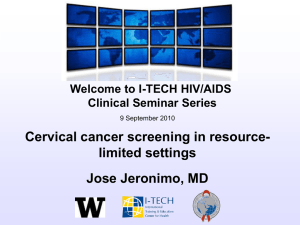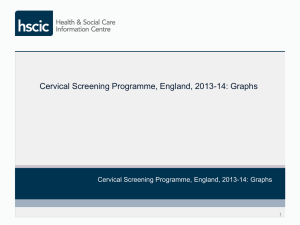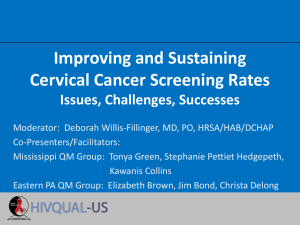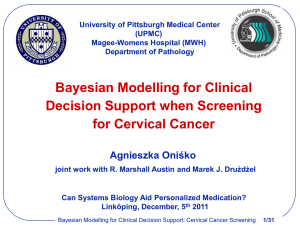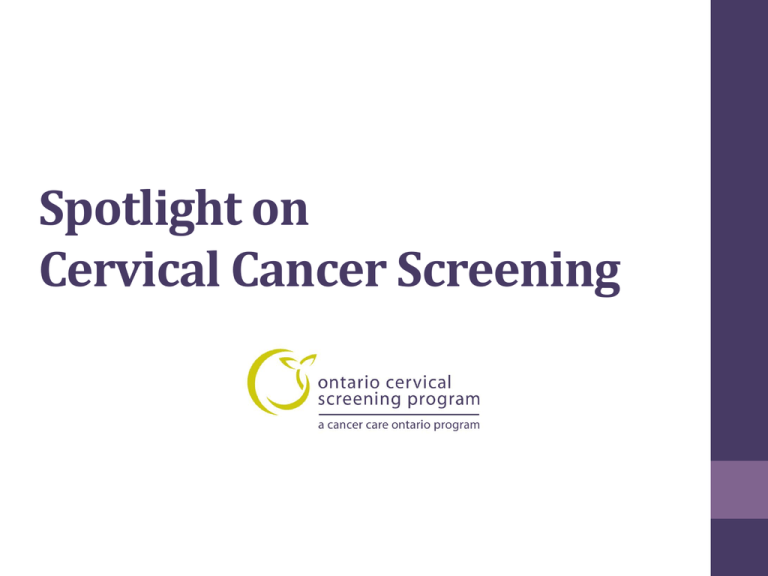
Spotlight on
Cervical Cancer Screening
Cervical Cancer Screening
• https://www.cancercare.on.ca/pcs/screening/cervscr
eening/
Ontario Cancer Statistics 2013
Cancer Type
Cervical
# New
Cases
3
610 (F)
# Deaths
150 (F)
3
Burden of Disease in Ontario
• Estimated 610 women will be diagnosed and
150 will die of cervical cancer in 2013
• Up to 80,000 abnormal Pap tests require
assessment each year
• 4th most common cancer among women
under age 50
4
Sensitivity and Specificity
Cancer
Test
Site
Cervical Pap
test
Cervical HPV
test
Sensitivity
Specificity
44% to 78%
91% to 96%
88% to 93% * 86% to 93%
*Sensitivityfor
CIN II
5
Effectiveness of Screening
Cancer
Site
Cervical
Effectiveness of
Screening
With Pap testing:
Incidence and
mortality reduced by
up to about 80% with
regular screening
Type of
Studies
Observation
al studies
and Global
incidence
data
6
Cervical Abnormalities
Cancer
(0.015%)
Atypical
Glandular
Cells (0.1%)
Atypical Squamous
Cells: HSIL Cannot
be Excluded (0.1%)
High-Grade Squamous
Intraepithelial Lesion
(HSIL) (0.3%)
Pre-cancer lesions/
Pap abnormalities: 80,000
Low-Grade Squamous
Intraepithelial Lesion (2.1%)
Atypical Squamous Cells of Undetermined
Significance (2.3%)
Negative for Intraepithelial Lesion or Malignancy
(95.0%)
Women (aged 20–69) Eligible for Cervical Cancer
Screening
7
7
Ontario Screening Data
• 65% of women aged 20 to 69 screened
(2009 to 2011)
• Ontario Cancer Plan provincial target is
85% participation for cervical screening
• Of the 454 women diagnosed with
invasive cervical cancer in 2008, 60%
were under-/never-screened and 40%
were screened
8
Cervical Cancer Causes
• Persistent infection with high risk
(oncogenic) types of HPV (human
papillomavirus)
• HPV is commonly found in sexually
active men and women and
transmitted through any skin to skin
sexual contact
• Most HPV infections are transient;
about 90% will clear within 2 years
9
Cervical Cancer Causes
• Pap tests detect cervical cell changes that
are a result of HPV infections
• Some abnormal Pap tests are also a
reflection of premalignant change
• Other co-factors (like smoking), that are
not well-understood, are also involved in
oncogenesis
10
Cervical Cancer Natural History
HPV Vaccine
• Two vaccines—bivalent (Cervarix®) and
quadrivalent (Gardasil®)—prevent 2 high
risk HPV types that cause 70% of cervical
cancers
• Injected in 3 doses over 6 months
12
HPV Vaccine
• Provides best protection if received prior to
HPV exposure
• Natural infection does not reliably result in
immunity
• Does not replace regular cervical cancer
screening
13
Ontario
HPV Vaccination Program
• Publicly funded school-based immunization
program for grade 8 girls
• New catch-up program since September
2012 for girls in grades 9-12
• 59% uptake in grade 8 girls (2009/2010)
• More vaccine program information at
www.hpvontario.ca
14
Current Guidelines
• Clear evidence for primary HPV screening
with cytology triage, starting at age 30,
every 5 years
• Must implement within organized program
• Must be publicly funded
• Follow cytology-based guidelines during
transition to funded HPV screening
15
Comparison of
2005 and 2011Guidelines
Question
Initiation
Interval
after
Negative
Test
Cessation
2005 Guidelines
2011 Guidelines
Within 3 years of first vaginal sexual
activity with cytology (Pap test)
Age 21
Annual until 3 consecutive negative
cytology tests, then every 2 to 3 years
Every 3 years
Age 70 if adequate and negative
screening history in previous 10 years
(≥ 3 negative tests)
No change
Management guidelines for follow-up of abnormal cytology did not change
Guidelines summary: www.cancercare.on.ca/screenforlife
Screening Initiation
Start at age 21 in sexually active women
(includes intercourse as well as digital and/or
oral sexual activity involving the genital area
with a partner of either gender)
• Cervical cancer rare < 25 years and
extremely rare < 21 years
• 10 to 15 years to develop cervical cancer
17
STI Screening
• The new guidelines for cervical screening
do no affect the guidelines for STI
screening
• Asymptomatic sexually active females
under age 25 should be screened annually
for chlamydia, or more often if there are
multiple partners
18
Harms of Screening Adolescents
• 90% will clear infection within 2 years
• High rates of low-grade mostly transient and
clinically inconsequential abnormalities
• Unnecessary anxiety from detection,
biopsies and treatment
• Treatment linked to possibility of adverse
future pregnancy outcomes
• No protective effect with screening
19
Screening Interval
• Cytology screening every 3 years unless
immunocompromised or previously
treated for dysplasia
• No incremental benefit of screening more
frequently than every 3 years
• Aligns with other jurisdictions
20
Screening Cessation
Stop screening at age 70 if adequate and
negative screening history
• Low incidence of cancer in women
who have been adequately screened
• Potential discomfort of procedure
• Difficulties visualizing
squamocolumnar junction
21
Cervical Screening Participation Rate
100
Ontario Cancer Plan target 2010: 85%
90
80
70
60
50
40
30
20
10
0
2000-2002
2003-2005
2006-2008
2009-2011
Cervical Screening Participation
Rate by Age
100
Ontario Cancer Plan target 2010: 85%
90
80
70
60
50
40
30
20
10
0
20-29
30-39
2000-2002
40-49
2003-2005
2006-2008
50-59
2009-2011
60-69
Cervical Screening Participation
Rate by LHIN
100
Ontario Cancer Plan target 2010: 85%
90
80
70
60
50
40
30
20
10
0
2000-2002
2003-2005
2006-2008
2009-2011
Colposcopy Rate Following a High-Grade
Abnormal Pap Test at 6 Months
100
90
80
70
60
50
40
30
20
10
0
2008
2009
2010
2011
Challenges
• Cervical cancer screening often linked to
periodic health exam, hormonal
contraception and bimanual exam
• Difficult for physicians/providers to track 3year screening interval
• Roll-out of program correspondence started
in 2013
26
CCO Initiatives Underway
Phased correspondence to women started in
Fall of 2013
• Privacy notification
• Result (normal, abnormal, unsatisfactory)
letters
• Followed by recalls and invitations
27
Opportunities
• Updated guidelines reflect new evidence
• Increase awareness of balance between
benefits and potential harms of screening
• Reduce interventions in young women
whose abnormal Pap tests are due to
transient and inconsequential HPV
infections
• Increase screening rates for under-/neverscreened groups
28
Opportunities
• Improve appropriate follow-up after
abnormal Pap test result
• Continue to encourage primary
prevention through HPV immunization
• CCO and Public Health Ontario
evaluating impact of primary and
secondary prevention of HPV-related
disease
29
Screening: Future State
• Clear evidence for primary HPV screening
• Must be implemented within an organized
program
• HPV test must be publicly funded
• Updated cytology guidelines to bridge
transition
30
Future Considerations
CCO working with ministry regarding
implementation of primary HPV screening
• Public funding of HPV test
• Family physician/primary care provider
education/information
• Laboratories
• Organization of colposcopy services
31
Clinical Case Study 1
• A 17-year-old old female sees you to
initiate birth control pill
• She started having unprotected
intercourse 2 months ago
Do you screen her for
cervical cancer?
32
Clinical Case Study 2
• A 69-year-old female had a normal Pap
test when she was 59 years old, an
abnormal test when she was 63 years old
and a normal Pap test most recently when
she was 66
At what age can she safely
stop screening?
33
Cervical Cancer Resources
For more information:
https://www.cancercare.on.ca/pcs/screening/cervscreening/hcpresources/
https://www.publications.serviceontario.ca/pubont/servlet/ecom/
https://www.cancercare.on.ca/pcs/screening/cervscreening/patient_education/
Questions?
Thank You
35

